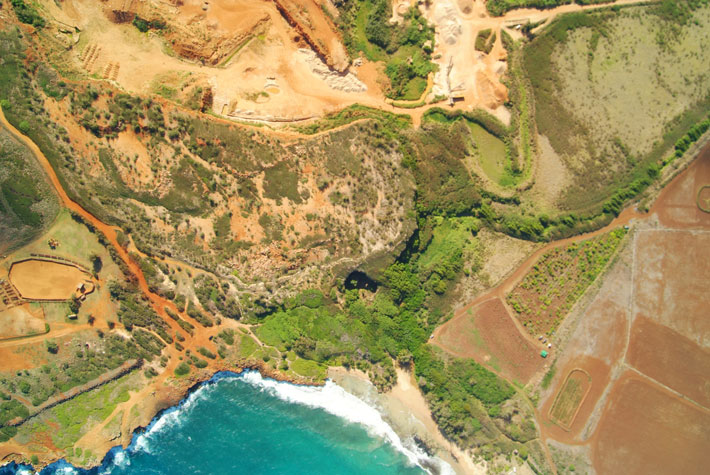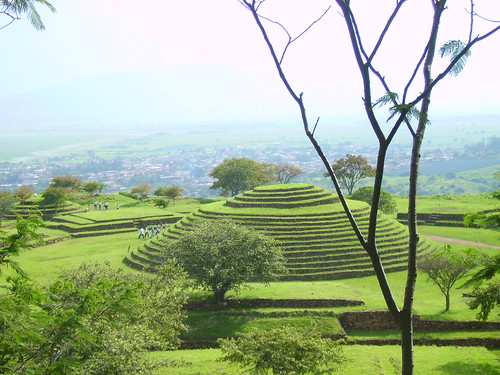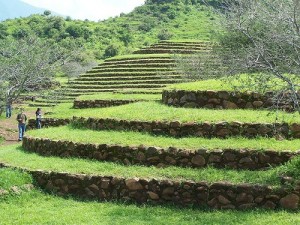Judi Lynn
Judi Lynn's JournalLetter From Hawaii: Inside Kauai's Past
Letter From Hawaii
Inside Kauai's Past
Ideal conditions within an ancient cave system are revealing a rich history that reaches back to a time before humans settled the island and extends to the present day
By ANDREW LAWLER
Friday, April 03, 2015
On a recent winter day, Burney is shin-deep in the tar-black ooze at the bottom of one of the excavation pits. He typically locates them at the periphery of the sinkhole, against the cave’s walls, where the stratigraphy is clearer. He motions to me to clamber down a 20-foot aluminum ladder and gives me a history lesson as I descend. After the first few rungs, I leave behind the period after Captain James Cook landed on Kauai in January 1778, the first European known to have visited Hawaii. Plastic, glass, and metal artifacts abruptly cease and are replaced by giant boulders, gravel, and sand in the level below, dated to about four or five centuries ago, unmistakable signs of an enormous tsunami which Burney and his colleagues believe originated from a massive earthquake in the eastern Aleutian Islands. This event, no doubt a catastrophe for the people living on the Kauai coast, deposited a great deal of debris and sealed off the prehistoric layers deposited in the cave from those of the later era of Western contact, leaving the material below undisturbed and uncontaminated.

[font size=1]
(Courtesy Ellen Coloumbe/Wings over Kauai)
An aerial view of the ecological reserve in which Makauwahi Cave is located
[/font]
Natives and tourists had long known about Makauwahi Cave, but it was Burney who, in August 1992, first grasped its significance for understanding Hawaii’s long and varied history, when he, Lida, and researchers Storrs Olson and Helen James from the Smithsonian Institution stumbled on the site while on vacation. At the time, the Burneys were at New York’s Fordham University and had a keen interest in ecological history and paleontology. One afternoon, while walking on a nearby beach, Burney spotted fresh footprints that appeared to lead into the brush. Curious but cautious, he followed the prints to a small hole at the foot of a cliff, just big enough to crawl through. Inside, he found himself within a giant oval bowl, but he couldn’t see much else through the dense growth and the afternoon’s lengthening shadows.
The next morning, before the sun had reached the interior, the two couples were back with a bucket augur, a small hand-powered drill that can pull material up from below ground, making only a small puncture in the surface, not greatly disturbing the site. The first bore went down 10 feet, and Burney found three species of extinct land snails, important indicators of ancient environmental conditions. In the second sample was a small bird skull. “If you got that much good stuff by drilling two small holes, then I couldn’t imagine what was waiting,” he says. “I’ve spent much of my life looking for two things—lakes and caves that have fossils in them,” says the peripatetic scientist, who had flitted in this pursuit from the North Carolina sounds to the Serengeti plains to the jungles of Madagascar before moving to Kauai to devote himself to studying Makauwahi Cave. “If you can find a lake inside a cave, it’s more than twice as good because you get the benefit of both types of fossil-forming environments.”
At Makauwahi, the conditions are remarkable. The alkaline limestone and the acidic groundwater cancel each other out and create the perfect neutral pH. “This is the Goldilocks zone—just right,” he says. “Everything in here is preserved. It’s like pages in a diary. And this process has been operating for thousands of years.” An acidic environment would have destroyed bones, while an alkaline environment would have destroyed plant fossils. But here, not just animal fossils, but also shells, seeds, leaves, and wood, as well as billions of microscopic algae, pollen, and spores are embedded in the layers that extend as far as 33 feet deep to the sinkhole’s floor.
More:
http://archaeology.org/issues/177-1505/letter-from/3144-letter-from-hawaii-kauai-caves
The Normalization of U.S.-Cuba Relations: the Best Accomplishment of President Barack Obama
Monday, April 13, 2015
The Normalization of U.S.-Cuba Relations: the Best Accomplishment of President Barack Obama
by Rodrigue Tremblay
(Author of the books “The Code for Global Ethics”, and
“The New American Empire”)
“At the beginning of 1959, United States companies owned about 40 percent of the Cuban sugar lands—almost all the cattle ranches—90 percent of the mines and mineral concessions—80 percent of the utilities—practically all the oil industry—and supplied two-thirds of Cuba's imports.”
Senator John F. Kennedy (1917-1963), (speech at a Democratic Dinner, Cincinnati, Ohio, October 6, 1960, during the 1960 Presidential campaign)
“I believe that there is no country in the world including any and all the countries under colonial domination, where economic colonization, humiliation and exploitation were worse than in Cuba, in part owing to my country's policies during the Batista regime.
—I approved the proclamation which Fidel Castro made in the Sierra Maestra, when he justifiably called for justice and especially yearned to rid Cuba of corruption. I will even go further: to some extent it is as though (Dictator) Batista was the incarnation of a number of sins on the part of the United States. Now we shall have to pay for those sins.
—In the matter of the Batista regime, I am in agreement with the first Cuban revolutionaries. That is perfectly clear.”
President John F. Kennedy, October 24, 1963, (interview with journalist Jean Daniel, The New Republic, published on December 14 1963, pp. 15-20)
More:
http://www.thenewamericanempire.com/tremblay=1168.htm
Colombia suspending use of anti-coca herbicide
Colombia suspending use of anti-coca herbicide
May 9, 2:09 PM EDT
BOGOTA, Colombia (AP) -- Colombia's President Juan Manuel Santos said Saturday he is halting use of a herbicide that is a key part of U.S.-financed efforts to wipe out cocaine crops.
Santos said he was taking the move following a Health Ministry recommendation based on a World Health Organization decision to classify glyphosate as a carcinogen.
Speaking at an event in the capital, Bogota, Santos said that defense and health officials should agree on a transition period, during which "spraying of glyphosate has to be replaced with other mechanisms, for example, intensifying manual eradication" of coca plants. The U.S. ambassador to Colombia, Kevin Whitaker, said a decision on whether to use the chemical is a decision for Colombia and the U.S. government respects it.
More than 4 million acres of land in Colombia have been sprayed with the popular weed killer over the past two decades to kill coca plants, whose leaves produce cocaine. The spraying program is partly carried out by U.S. contractors.
http://hosted.ap.org/dynamic/stories/L/LT_COLOMBIA_DRUGS?SITE=AP&SECTION=HOME&TEMPLATE=DEFAULT&CTIME=2015-05-09-13-52-03
(Short article, no more at link.)
Brazil's MST Pays Tribute to Landless Workers Killed by Police in 1996
Brazil's MST Pays Tribute to Landless Workers Killed by Police in 1996
Saturday, 09 May 2015 00:00
By Armando Carmona, Truthout | News Analysis

[font size=1]
Shacks occupied by members of the Landless Workers' Movement in Brazil.
(Photo: Matteo Turilli/Flickr)
[/font]
Landless rural workers occupy farms in Brazil to fulfill the promises and obligations of a people's agrarian reform movement and to reclaim a sense of justice. Land occupations in Brazil happen continuously throughout the year, however, the month of April - called "Red April" (Abril Vermelho) - pays tribute and remembrance to the Landless Workers Movement's (MST) fallen comrades of the Eldorado dos Carajas massacre. More than 46 land occupations in 15 states occurred between April 17 and 24. In the south of Mato Grosso, the MST's largest occupation now includes more than 1,500 families.
On April 17, 1996, 21 political militants of the MST were killed by military police. Nineteen were killed immediately and three died days after; 69 additional people were injured in the shooting. The MST members were blocking a road in the northern state of Para. Military police responded to an order by then Gov. Almar Gabriel, who ordered them to remove the roadblock, and then Secretary of Public Safety Paulo Camara, who authorized the use of force. Reports state that close to 150 police were involved in the shooting. In 2012, nearly 16 years after the actual killing of these MST members, only two officers, Col. Mario Colares Pantoja and Maj. Jose Mauriz Pereira de Oliveira have been tried in court: Pantoja was sentenced to 228 years in prison and Oliveira to 158 years.
The Eldorado dos Carajas massacre has reverberated through the hearts and minds of the MST for nearly two decades. It has been a rallying cry for those who denounce violence in the fields and a key example for how impunity for state officials exists when dealing with concerns of the landless people. While two officers have been imprisoned, that is an inadequate response that does not reverberate with what the movement understands as justice for their societal and political concerns. Justice for the MST is not limited to a judicial response to individual atrocities such as the Eldorado massacre, but a systemic response to the conditions that allow these types of incidents to exist.
"The organization of the state and its judicial branches have laws that emerge from a capitalist system. Brazil's history is marked by legislation that has privileged the interests of the market," said Bruno Rodrigo Silva Diogo from the MST Statewide Direction in Minas Gerais. The MST argues that violence and discrimination against landless workers exist because agrarian reform - land reform - has yet to be put into practice.
More:
http://www.truth-out.org/news/item/30620-brazil-s-mst-pays-tribute-to-landless-workers-killed-by-police-in-1996#
How Cuba Could Stop the Next Ebola Outbreak
How Cuba Could Stop the Next Ebola Outbreak
West Africa’s medical system was brought within an inch of its life by a devastating epidemic. But Havana could help nurse it back to health.
By Laurie Garrett
May 6, 2015
What follows is a modest proposal. It endeavors to solve three crucial problems all at once: U.S.-Cuba relations; the post-Ebola human resources deficits in physicians for Guinea, Sierra Leone, and Liberia; and the scarcity of skilled nurses in those same countries.
When the Ebola virus of the recent outbreak first surfaced, undetected in the village of Meliandou, Guinea, in December 2013, its spread across those countries was in part facilitated by the desperate state of health-care systems in the three poor, post-civil war nations. These countries never did have enough skilled health workers; Ebola has claimed the lives of devastating numbers in their ranks; and slowing the epidemic prompted the nations to lean heavily on the generosity of the Cuban government, which sent physicians to West Africa’s rescue. In many cases, the Cubans toiled inside facilities financed by U.S. taxpayers, and poignantly the U.S. Department of Defense swore willingness to treat infected Cubans should it be necessary — in the Army-built treatment unit outside Monrovia, Liberia.
This dramatic alignment of U.S., Cuban, and African interests, born from the exigencies of the Ebola epidemic, should now be directed to the reconstruction of the health-care systems of Liberia, Sierra Leone, and Guinea.
Liberia, with a population of 4.3 million, had 51 licensed physicians and 1,649 nurses, ambulance drivers, dentists, pharmacists, lab technicians, hospital clerks, and other health personnel. The 6.1 million people of Sierra Leone had just 136 physicians and 2,299 other health-care workers. And Guinea’s population of 11.8 million people were treated by 1,175 physicians and 6,179 other health personnel. (Consider the World Bank’s data for 2010: The United States had 2.4 doctors for every 1,000 Americans, while Guinea had 0.1 physicians for every 1,000 Guineans.)
More:
https://foreignpolicy.com/2015/05/06/cuba-ebola-west-africa-doctors/
Cuban refugees could be blocked from returning home
Cuban refugees could be blocked from returning home
By Megan O'Matz and Sally Kestin
Sun Sentinel
▼ Proposed changes to Cuban Adjustment Act would be most significant in half a century
▼ Some members of Congress seeking to curtail frequent travel to Cuba by refugees
▼ Pressure building to reform the Cuban Adjustment Act
The U.S. welcomes thousands of Cubans each year as presumed refugees fleeing political repression, no questions asked. Yet many exploit the special treatment they receive by shuttling back and forth to the island that is allegedly persecuting them..
Now a Miami congressman wants to end that with legislation that would prevent new arrivals from freely traveling back to Cuba until they become U.S. citizens. If adopted, the revisions would pose the most dramatic alterations to the Cuban Adjustment Act in nearly 50 years.
U.S. Rep. Carlos Curbelo, the son of Cuban exiles, is crafting a proposal that would require Cubans seeking entry under the act to attest that they are political refugees. Those who return to the island would face consequences: quite likely the loss of their legal status.
"We are aware of abuses of the Cuban Adjustment Act and are looking to tighten it to assure that only those facing oppression in Cuba can take advantage," Curbelo told the Sun Sentinel in a statement provided by his office.
More:
http://www.sun-sentinel.com/local/broward/fl-congress-cuban-adjustment-act-curbelo-20150510-story.html#page=1
New documentary reveals how three workers from East Kilbride grounded Chile tyrant General Pinochet'
New documentary reveals how three workers from East Kilbride grounded Chile tyrant General Pinochet's jets of destruction
08:14, 9 May 2015
By Anna Burnside
FILMMAKER Felipe Bustos Sierra tells how trade unionists Bob Fulton, Robert Somerville and John Keenan took a stand against the military regime in South America.

[font size=1]
General Pinochet and the Hawker Hunter jets he used to help stage his military coup in Chile
[/font]
FROM a distance, Bob Fulton, Robert Somerville and John Keenan bear a strong resemblance to Jack and Victor from Still Game.
Bob is 92, Robert 78 and John 75. But these auld fellas in bunnets and zip-up jackets are folk heroes in South America.
They have already been the subject of a short film and director Felipe Bustos Sierra is raising cash to make it a feature-length documentary.
In 1973, the trio worked in the Rolls-Royce factory in East Kilbride.
They watched the coup in Chile on TV and were horrified as general Augusto Pinochet’s fighter planes bombed president Salvador Allende out of the royal palace.
More:
http://www.dailyrecord.co.uk/news/real-life/new-documentary-reveals-how-three-5661023
Colombia to extradite suspected killer of Venezuela lawmaker
May 8, 2015
Colombia to extradite suspected killer of Venezuela lawmaker
posted by Matthew Dancis
Colombian president Juan Manuel Santos on Thursday authorized the suspected mastermind behind the killing of a Venezuelan politician to be extradited to Caracas.
Former Colombian paramilitary Leivar Padilla, a.k.a. “Colombia” is the alleged mastermind behind the murder of Venezuela’s Robert Serra, and has been pursued by the Venezuelan government for several months.
Police found Serra and his partner stabbed to death in his home last October. Delays in his extradition have reportedly created tensions between the neighboring nations.
Venezuelan President Nicolas Maduro is convinced that Serra’s murder was politically influenced. Maduro’s suspicion was corroborated by Serra’s bodyguard, who confessed to conspiring with Colombian paramilitary members to arrange his assassination.
More:
http://colombiareports.co/colombia-to-extradite-suspected-killer-of-venezuela-lawmaker/
Chilean judge orders detentions in priest's disappearance
Chilean judge orders detentions in priest's disappearance
May 8, 4:20 PM EDT
SANTIAGO, Chile (AP) -- A Chilean judge is ordering the detention of 14 retired military members and four former police officials in the disappearance of the Rev. Michael Woodward during the country's dictatorship.
Friday's decision by Judge Jaime Arancibia is a shift in the case, which had been dismissed. Persistence of the family and new evidence led to it being reopened.
The detainees include two former vice admirals and four captains.
According to the judge, the priest of Chilean and British origin was detained in September 1973 at a university in the port city of Valparaiso and kept at various naval facilities, where he was tortured. His body was later delivered to a naval hospital.
More:
http://hosted.ap.org/dynamic/stories/L/LT_CHILE_DICTATORSHIP_DETENTIONS?SITE=AP&SECTION=HOME&TEMPLATE=DEFAULT&CTIME=2015-05-08-16-20-15
LBN:
http://www.democraticunderground.com/10141088773
[center]
Rev. Michael Woodward


La Esmeralda, one of Chile's Pinochet's three torture ships,
and the last place where Michael Woodward drew his last breath.[/center]
Saturday, August 28th 2010 - 06:46 UTC
Indictments related to the killing of Anglo Chilean priest in 1973 total 33
Chilean Justice indicted on Friday fourteen former members of Carabineros (militarized police and Navy) for the kidnapping and killing of Anglo-Chilean Catholic priest Miguel Woodward.
He was tortured to death in 1973 by agents from General Pinochet’s military dictatorship on board the Navy school vessel, “Esmeralda”.
“It is with great satisfaction that we have been informed of the indictment which is now completed and closes this line of investigation that has been on-going for years”, said Karina Fernández, solicitor from the Ministry of Interior Human Rights Program which acted as plaintiff.
Magistrate Eliana Quezada from Valaparaíso Appeals Court said that “it was a kidnap, a crime related to crimes coordinated from the very organization of the (Chilean) Navy”.
Contrary to other human rights violations case, the homicide of Father Woodward was not executed by a “repressive organism” from the (Chilean) State but rather by an institution such as the Navy.
More:
http://en.mercopress.com/2010/08/28/indictments-related-to-the-killing-of-anglo-chilean-priest-in-1973-total-33
[center]~ ~ ~[/center]
In fact she has a rather sordid history. According to reports by the United States Senate, Amnesty International and the Chilean Truth and Reconciliation Commission, the Esmeralda was used as a floating torture chamber for dissidents and political prisoners from 1973 to 1980. This is during the reign of Dictator General Augusto Pinochet, who aided by the United States government, successfully plotted and carried out a coup to kill and usurp the democratically elected socialist President Salvador Allende.
In 1973, Maria Comene was held as a political prisoner on the ship for 10 days."It is a bad boat," Comene says. "A boat where blood was spilled."
It is suggested that over 110 prisoners, seventy men and forty women, were kept on board, subject to rape and genital shocks and brutal beatings. It is said that the British priest Michael Woodward died as a result of the brutal interrogation and torture he endured on the rigger. A good synopsis of the ship's bloody history can be found here. The Amnesty International document here.
More:
http://www.blueheronblast.com/2011/07/la-esmeralda-de-sangria.html
Up, up and away: how the Guachimontones travelling balloon is elevating Mexico's design scene
Up, up and away: how the Guachimontones travelling balloon is elevating Mexico's design scene
Design / 8 May 2015 /
By María García Holley

[font size=1]
Norberto Miranda Feldhahn - a young, Guadalajara-based architect - has designed the Guachimontones balloon, a travelling inflatable exhibition
[/font]
Travelling exhibitions have existed for centuries. From the ancient mercantile barter to the Renaissance cabinet of curiosities, traders and merchants have long roamed far and wide, showcasing their products and concepts in new markets. But what of items that can't travel? Structures and land?
In Jalisco, a western state of Mexico's Pacific Coast there is a prehispanic archaeological complex called Guachimontones. The ruins of this beautifully rounded pyramid lie forgotten despite their rich heritage and archeological significance, purely because of geographic misfortune and urbanisation. In a bid to benefit tourism, as well as education, the Minister of Culture for Jalisco did what any man in his place would do: commissioned an exhibition. The formula is simple enough, after all; a couple of screens, simple labels, nice pictures and a timeline. It is unfortunate that government policies, especially in Mexico, aren't in the design race. They are dusty, old institutions, far from the avant-garde, conscious criticism and, more tragically, means to break the mould.
Enter Norberto Miranda Feldhahn. This young, Guadalajara-based architect was aware of the challenges when he took on the commission. His idea for an archeological complex was bold, but he prevailed and went on to shake the cultural bureaucratic apparatus, pushing the boundaries of the traditional archaeological exhibition, transforming it into an immersive, educational design experience instead.
Like a travelling circus, the Guachimontones balloon arrives at local schools all packed up, ready to unveil the story of a civilisation that once pioneered the worlds of agriculture and crafts. First it erects a flag, announcing the beginning of the show as excitable children gather curiously, waiting for the giant white balloon to inflate.
Read more at http://www.wallpaper.com/design/up-up-and-away-how-the-guachimontones-travelling-balloon-is-elevating-mexicos-design-scene/8836#XzDOSxA4vPmPte1V.99
[center]~ ~ ~[/center]
Wikipedia description of Guachimontones:
Los Guachimontones (alternatively Huachimontones) is a prehispanic archaeological site near the Mexican town of Teuchitlán in the state of Jalisco about an hour west of Guadalajara. It is the major site of the so-called Teuchitlan tradition,[1] a complex society that existed from as early as 300 BCE until perhaps 900 CE.
The dominant features at los Guachimontones are circular stepped pyramids in the middle of circular building complexes. The 60-foot (18 m) tall pyramid at Circle 2 has 13 high steps leading to an upper level, which was then topped with another 4 high steps. A post hole was located at the very highest level, most likely for Volador ceremonies.[1] The pyramids may also have supported small temples.
The word Teuchitlán is derived from Teotzitlán or Teutzitlán interpreted as "place dedicated to the divine", "place of the God Tenoch " or "place dedicated to the revered God".[2]
Possibly the city foundation goes back to the Aztecs, which erected it on a hill called Huachimontón, north of its current location.[2] It was founded by members of Nahuatlacas groups that developed central Mexico during the postclassical period, however it is known that buildings at Teuchitlán were built prior to such development. The creative culture that constructed "'Guachimontones"' is called Teuchitlan tradition, its apogee was between 200 and 400 CE, disappearing in about 900 CE, possibly before the arrival of the Anahuaca colonists.
UNESCO World Heritage List[edit]
UNESCO has added the whole region, including the nearby tequila distilleries, to its World Heritage List. Due to heavy looting, the site was also included on the 2008 World Monuments Watch list of 100 Most Endangered Sites.
Cont'd
[font size=1]
Circular stepped-pyramid at the Guachimontones location known as
'Circle 2'
[/font]
[font size=1]
Model of the site
[/font]
More:
http://en.wikipedia.org/wiki/Guachimontones
[center]


 [/center]
[/center]
More images at google images:
https://www.google.com/search?sourceid=navclient&ie=UTF-8&rlz=1T4TSND_enUS566US566&q=Guachimontones&tbm=isch&gws_rd=ssl
Profile Information
Member since: 2002Number of posts: 160,530

